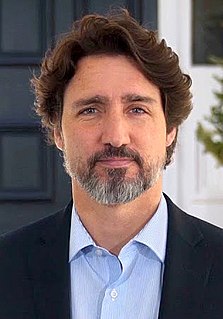
The prime minister of Canada is the head of government, chair of the Cabinet, and primary minister of the Crown. Canadian prime ministers are styled as The Right Honourable, a privilege maintained for life.

A coat of arms is a heraldic visual design on an escutcheon, surcoat, or tabard. The coat of arms on an escutcheon forms the central element of the full heraldic achievement which in its whole consists of: shield, supporters, crest, and motto. A coat of arms is traditionally unique to an individual person, family, state, organization or corporation.

The Arms of Canada, also known as the Royal Coat of Arms of Canada or formally as the Arms of Her Majesty The Queen in Right of Canada, is, since 1921, the official coat of arms of the Canadian monarch and thus also of Canada. It is closely modelled after the royal coat of arms of the United Kingdom with French and distinctive Canadian elements replacing or added to those derived from the British version.

In heraldry, supporters, sometimes referred to as attendants, are figures or objects usually placed on either side of the shield and depicted holding it up.
The Royal Standards of Canada are a set of uniquely Canadian personal flags approved by the Queen of Canada for use by members of the Canadian Royal Family. They are used to denote the presence of the bearer within any car, ship, airplane, building, or area, within Canada or when representing Canada abroad. There are six personal royal standards, one each for the Queen, the Prince of Wales, the Duke of Cambridge, the Princess Royal, the Duke of York, and the Earl of Wessex, as well as one standard for use more generally to denote the presence of any member of the Royal Family who has not previously been provided with a specific personal standard. The flags are part of a larger collection of Canadian royal symbols.

The Lieutenant Governor of Nova Scotia is the viceregal representative in Nova Scotia of the Canadian monarch, Queen Elizabeth II, who operates distinctly within the province but is also shared equally with the ten other jurisdictions of Canada, as well as the other Commonwealth realms and any subdivisions thereof, and resides predominantly in her oldest realm, the United Kingdom. The Lieutenant Governor of Nova Scotia is appointed in the same manner as the other provincial viceroys in Canada and is similarly tasked with carrying out most of the monarch's constitutional and ceremonial duties. The present, and 33rd, Lieutenant Governor of Nova Scotia is Arthur Joseph LeBlanc, who has served in the role since 28 June 2017.

John William Maule Ramsay, 13th Earl of Dalhousie KT, PC, styled Lord Ramsay between 1874 and 1880, was a Scottish naval commander, courtier and Liberal politician. He served as Secretary for Scotland in William Ewart Gladstone's short-lived 1886 administration.

The Canadian Heraldic Authority is part of the Canadian honours system under the Canadian monarch, whose authority is exercised by the Governor General of Canada. The authority is responsible for the creation and granting of new coats of arms, flags, and badges for Canadian citizens, government agencies, municipal, civic and other corporate bodies. The authority also registers existing armorial bearings granted by other recognized heraldic authorities, approves military badges, flags, and other insignia of the Canadian Forces, and provides information on heraldic practices.

The Royal Heraldry Society of Canada is a Canadian organization that promotes interest in heraldry in Canada. It was founded in 1966 and granted royal patronage in 2002.
The Secretary to the Governor General is the administrative head of the Office of the Secretary to the Governor General of Canada and is based at Rideau Hall in Ottawa, Ontario. The position is one of the oldest public service appointments in Canada and holds the courtesy rank of deputy minister within the Public Service of Canada.

Chief Herald of Canada is the title held by the head of the Canadian Heraldic Authority. The Chief Herald of Canada directs the operations of the Canadian Heraldic Authority and makes the grants of arms. There are exceptions to this, such as certain grants made directly by the Governor General. The position is currently held by Samy Khalid.
Simon Fraser, 13th Lord Lovat and 2nd Baron Lovat, was a Scottish peer. While legally the 13th Lord, he was referred to as the 15th Lord Lovat.
Saguenay Herald of Arms is the title of one of the officers of arms at the Canadian Heraldic Authority in Ottawa. Like the other heralds at the Authority, the name is derived from the Canadian river of the same name. Saguenay Herald of Arms is the Assistant Registrar of the Canadian Heraldic Authority. As such, Saguenay assists Saint-Laurent Herald in the registration duties. Together they also have specific responsibilities for the bilingual texts of the grant and registration documents.
Thomas Alexander Fraser, 12th Lord Lovat and 1st Baron Lovat, KT was a Scottish peer. He was also the 21st MacShimidh, the traditional Gaelic Patronym for the Chiefs of the Clan Fraser.

Canadian heraldry is the cultural tradition and style of coats of arms and other heraldic achievements in both modern and historic Canada. It includes national, provincial, and civic arms, noble and personal arms, ecclesiastical heraldry, heraldic displays as corporate logos, and Canadian heraldic descriptions.
A heraldic authority is defined as an office or institution which has been established by a reigning monarch or a government to deal with heraldry in the country concerned. It does not include private societies or enterprises which design and/or register coats of arms.
Richard Henry Rupert Bertie, 14th Earl of Lindsey and 9th Earl of Abingdon is an English peer.











